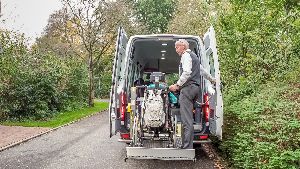A Guide to Rear- and Side-Entry Mobility Vans

When you're thinking about purchasing a mobility car, there are a lot of options you'll need to consider. Most cars can be adapted or purchased for mobility needs with today's technology, from trucks to vans to full-sized SUVs. Here's a quick overview of the two most common types of vehicle accessibility available.
What Are Mobility-Accessible Vehicles?
A mobility vehicle is any vehicle that allows access for wheelchair or scooter users. These cars are typically more spacious than other cars to accommodate larger mobility aids, and most include a ramp or a lift to help the user enter the car more easily. Before choosing a vehicle, it's important to decide which entry type would be most beneficial for you or a loved one. Here is a quick breakdown of the two most popular types of accessible vehicles: side-entry and rear-entry.
What Benefits Does a Side-Entry Offer?
Side-entry vehicles are the most popular type of mobility vehicle on the market. These cars have wheelchair and scooter accessibility on the side of the vehicle. Additionally, the floors in side-entry vehicles are lower to allow wheelchair users to enjoy more headspace.
Side-entry mobility cars are desirable for their ease during curbside pick-ups and drop-offs. Also, seats in the vehicle can be removed to provide more options for wheelchair and scooter users, including allowing them to ride in the passenger seat or drive the car. Keep in mind, however, that these mobility vehicles will need more driveway space than usual to allow the individual enough space to exit the car safely and efficiently.
What Benefits Does a Rear-Entry Offer?

Rear-entry mobility cars are similar to side-entry, but the most significant difference is the ramp's location at the back of the vehicle. Rear-entry cars are desirable because they require less modification of the entire car; where side-entry vehicles may have to have the middle row of seats removed to accommodate entry, rear-entry vehicles can usually keep these seats.
Consider the use of the car before purchasing a rear-entry vehicle. This configuration does not allow the wheelchair user to occupy the passenger or driver's seats, so be sure to consider whether or not this is important to you when purchasing these vehicles. Additionally, remember that parallel parking isn't entirely possible in rear-entry mobility cars because of the access needed for an individual to exit the vehicle.
If you're still looking for more information about adaptive driving aids and mobility cars, reach out Soderholm Bus & Mobility. This full-service car dealership offers the widest range of mobility aids for your driving needs. They've been locally owned and operated since 1989, and they've been helping the residents of Honolulu, HI, accommodate their mobility needs. Their technicians can help with many installation needs, such as inspections, repairs, lift installations, and specialty part installation. For more information, call (808) 834-1417, or visit their website to view their mobility products.
About the Business
Have a question? Ask the experts!
Send your question

